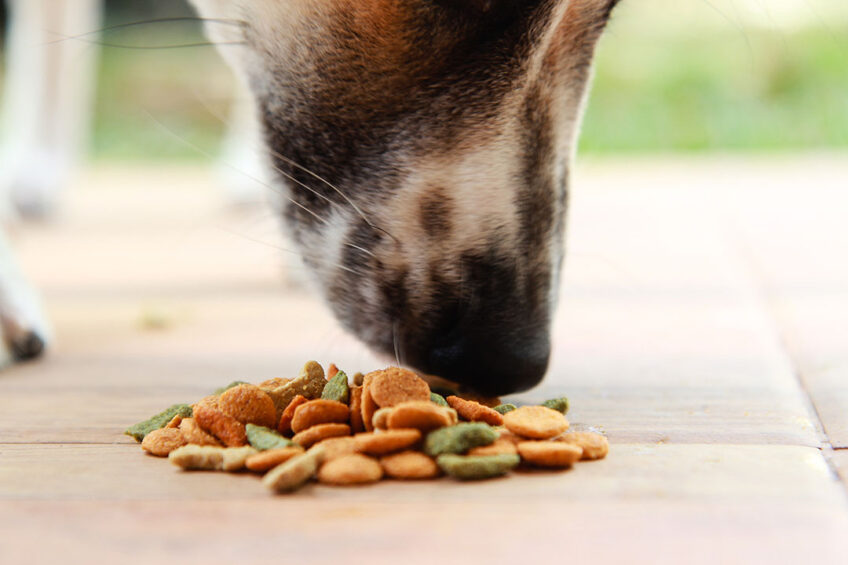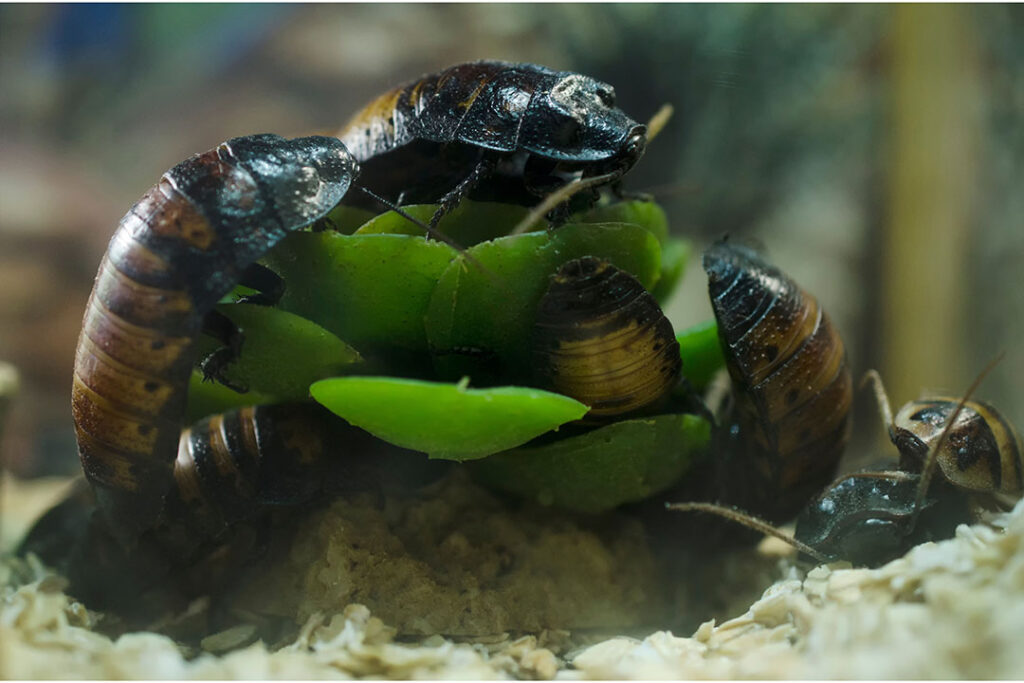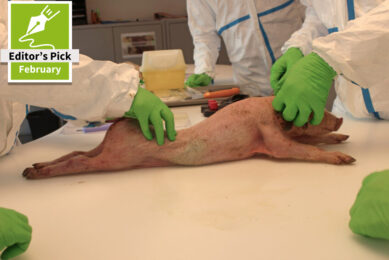Impact of dietary supplements on dogs’ gut health

Gut microbial community also known as the gut microbiota is a collection of bacteria, archaea, fungi, and viruses with essential roles in gut health and functions through the metabolism of dietary components. Therefore, various nutritional approaches including dietary supplementation of xenobiotics, insect-meal, prebiotics, probiotics, and antibiotics are used to manipulate gut health by targeting gut microbiota.
Gut health is an important aspect of companion animals’ well-being and welfare. In addition, gut health affects nutrient digestion and absorption, mucins and immunoglobulins secretion, energy generation, and the overall health status of dogs.
Dog gut microbiota from birth to adulthood
The composition of the gut microbiota alters over time and the bacterial composition of the gut microbiota displays significant interindividual variability in dogs. Early in life, at the 2-days of age mark, gut microbiota comprises of 29-95% Firmicutes, Proteobacteria and Fusobacteria. At the age of 2 months, the gut microbiota shows a higher diversity at the phylum level, with a predominance of Bacteroidetes, followed by Firmicutes, Fusobacteria and Proteobacteria. However, at that age, the gut microbiota profile varies between male and female dogs, predominantly represented by Firmicutes, Fusobacteria and Bacteroidetes in female dogs.
Gut microbiota along the gut tract
The gut microbiota varies along the gut tract. Factors including the acidic nature of the stomach, the profile of bile acids, the enzyme richness in the small intestine, and the low oxygen availability in the colon have a great impact on the type of microbiota species colonising in each segment. There is a gradual increase in bacterial diversity along the gut tract from the duodenum to the colon, and Firmicutes, Fusobacteria, Bacteroidetes, Actinobacteria, and Proteobacteria are the predominant phyla from the duodenal, jejunal, ileal and colonic digesta of healthy dogs.
Impact of diet on gut microbiota
Diet is a key factor affecting the gut microbiota structure and host metabolic functions. The gut microbiota evolves to adapt to high intakes of fibre, carbohydrate, and proteins. Dogs fed with bone and raw food show a decrease in the relative abundance of Firmicutes and Bacteroidetes involved in the digestion of dietary fibres. However, bone and raw food increases the abundance of Proteobacteria, Fusobacterium, Lactobacillus and Clostridium. Dogs fed with commercial food show a gradual rise in the relative abundance of bacterial taxa such as Prevotella and Sutterella, which break down carbohydrates, and a decline in the relative abundance of Parabacteroides .and Ruminococcaceae.
Impact of xenobiotics on gut microbiota
In healthy dogs, the administration of omeprazole (a proton-pump inhibitor) leads to higher proportions of Firmicutes and Fusobacteria, a decrease in gastric Helicobacter and an increase in the relative abundance of Helicobacter in the duodenum. In addition, dogs are exposed to environmental chemicals that affect the host and resident gut microbiota on a daily basis. For instance, bisphenol A, an endocrine-disrupting chemical widely present in food-can linings affects dog gut microbiota including Bacteroides spp., Clostridium hiranonis, Bacteroides uniformis, Ruminococcus spp., Roseburia spp., Megamonas spp., Fusobacterium spp., Ruminococcus spp., Pectinatus spp., Catenibacterium spp. and Faecalibacterium prausnitzii.

Impact of insect-meal on gut microbiota
Insect exoskeleton is a source of protein which develops and maintains healthy gut microbiota and inhibits the growth of harmful bacteria, thus decreasing the rate of inflammation and infection in the gut and improving gut health. A healthy diet of insect proteins is easy to digest, and it decreases the rate of indigestion and bloating. Moreover, chitin is a natural polysaccharide in the exoskeleton of insects which serves as a substrate for microbial fermentation in the hindgut and supports gut health. Feeding super worm increases the digestibility of dry and organic matter and protein, and the abundance of Prevotella, Faecalibacterium, Allobaculum, and Ruminococcaceae. Feeding cinerea cockroach lowers faecal pH and increases butyrate. Feeding Madagascar cockroach increases phenol level and the relative abundance of the phyla Proteobacteria and the genus Sutterella.
Impact of prebiotics on gut microbiota
Prebiotics are nondigestible compounds metabolised by microorganisms in the gut, modulating composition, and activity of the gut microbiota. Prebiotics reduce the risk of developing common gut conditions like leaky gut or inflammatory bowel disease. Furthermore, prebiotics reduce the rate of harmful bacteria growth in a pet’s body and assist pet’s body to eliminate the parasites, thus reducing the rate of parasitic infections. In dogs, an intake of 1.5% inulin reduces faecal pH and increases Bifidobacteria population. Dogs fed with relatively small amount of dietary fibre change the structure of gut microbiota, increase the density of Firmicutes, and decrease the density of Fusobacteria. Furthermore, dietary supplementation of fructooligosaccharides induces the growth of Bifidobacteria and improves the digestibility of several minerals in the entire gut tract.
Impact of probiotics on gut microbiota
Probiotics are defined as “live microorganisms that when administered in adequate amounts confer a health benefit on the host”. Probiotic cocktail containing Lactobacillus strains has positive effects on cytokine expression and T-cell regulation of dogs with chronic enteropathies. In addition, probiotics intensify T-cells, decrease relative abundance of Faecalibacterium population, and assist in recovery from the dysbiosis in dogs with inflammatory bowel disease. Supplementing puppies’ diet with Enterococcus faecium improves both gut mucosal level and systemic level and the protective immune response during the weaning period.
Impact of antibiotics on gut health
Antibiotics including metronidazole, tylosin, enrofloxacin are administered for dogs with chronic enteropathies when diet change does not work. Metronidazole acts on bacteria and protozoa and tylosin is used to treat tylosin-responsive chronic diarrhoea in adult dogs. Enrofloxacin is a fluoroquinolone useful in the therapy of granulomatous colitis of Boxer. However, abundant application of antibiotics in the treatment of certain diseases reduces beneficial gut bacteria population, facilitates the increase of potential pathogens population, promotes antimicrobial resistance, and contributes to the onset of dysbiosis.
Concluding remarks
The gut microbiota participates in the host vital physiological processes and development; thus, it is essential for overall health and welfare. Alterations of the gut microbiota are linked to various gut and systemic illnesses. Future research is required to clarify the mechanisms that regulate the interactions between the microbiota and the host and to understand the efficiency of dietary supplements.
*References available upon request.











